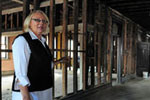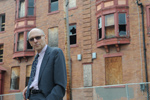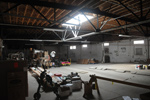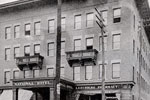
Category Archive: Pittsburgh Tribune Review
-
Historic Pittsburgh Home Bears Benign Swastika
By Bob Bauder
PITTSBURGH TRIBUNE-REVIEW
Sunday, October 31, 2010
Thelma J. Smith's home on Andover Terrace in the Upper Hill District bears a swastika in concrete above the entrance. Before fascism, the swastika was viewed as a good-luck symbol. Justin Merriman | Tribune-Review
Thelma J. Smith and her late husband faced a moral dilemma nearly 30 years ago: As black Americans, they had to decide whether they wanted a universal symbol of hate to remain imprinted on the front of their historic Hill District home.
The swastika was covered for decades by previous owners, and no one in the neighborhood, not even the Smiths until after they bought the house, knew it was there.
Thelma Smith thought of the Jewish neighbors, Holocaust survivors with concentration camp numbers tattooed on their arms.
What would they say? she asked herself.
More importantly, what would people in the community say?
The Smiths researched the subject. What they found, combined with what they knew about the house, swayed them.
The swastika predates Nazis by thousands of years. Before fascism, it was viewed as a good-luck symbol. The one in question was an original feature on a house that was then about 69 years old, the second-oldest home on an old street.
Smith, 72, had to explain all of that to the Jewish neighbors, who came to her upset but later agreed the swastika in this case is benign. It differs from the Nazi symbol in that it is not positioned at an angle.
“I just felt it was important historically to keep it,” Smith said.

A photo from 1912 shows the builder (Lindermer at far right) of Smith's home, which was built in 1912 for Herman S. Davis, who christened his home "Swastika." Justin Merriman | Tribune-Review
The house on Andover Place was built in 1912 for Herman S. Davis, who christened his new home “Swastika,” according to a photograph album that Smith inherited from previous owners and the March 1913 issue of Concrete-Cement Age magazine, which featured a story on the house.
Davis, whom Concrete-Cement Age identifies as a consulting engineer and astronomer, had his house built of poured concrete, a new architectural technique at the turn of the last century. He had the swastika, which Thelma Smith estimated is two feet square, imprinted in a prominent location on an exterior wall facing the street. Nobody knows why.
The house has 13 rooms and 48 windows. It is the only house in the region known to have a swastika as a design feature, according to representatives of Pittsburgh History & Landmarks Foundation.
Thelma Smith said the swastika was covered by wood when they bought the house in 1976. About 1981, they had the concrete cleaned and the wood removed.
Ever since, the house has been a conversation piece and curiosity for people traveling the narrow, tree-lined street. The house is technically in the Upper Hill, but it’s on the last street before Schenley Farms Historic District. It seems secluded with its large trees, empty lots on either side and a steep hill in back rising about 60 feet to Dakota Street.

"I just felt it was important historically to keep it," Thelma J. Smith said of the swastika imprinted on her home. Justin Merriman | Tribune-Review
Numerous people stopped over the years to ask Smith and her family about the swastika. Cars slow down as they pass. Smith said police officers patrolling at night have shined spotlights on the swastika, presumably for new officers to see.
The family doesn’t mind the attention, but an event in May was a bit much. Somebody came in the middle of the night and attempted to cover the swastika with cement. Smith’s youngest son, Lee, noticed it and found imprints from a ladder in the yard.
His mother, who didn’t hear anything that night — probably because of the thick concrete walls — suspects a student prank. The University of Pittsburgh campus is just down the street. She said the kids probably were scared away before completing the job, which would explain why the swastika was partially filled in.
“They needed to be scared if I would have caught them,” said Lee Smith, 35, a Pittsburgh City Football League most valuable player for Schenley High during the 1990s and still in good shape.
He said a run-in with his father, Donald L. Smith, who died in September, would have been worse. In his younger days, Donald “Toro” Smith was a professional heavyweight boxer, who once fought Joe Frazier before Frazier became world champion.
The family cleaned out the cement without damage to the swastika.
There it remains for all to see, just as Herman S. Davis intended. And there it will stay, as far as Lee Smith is concerned.
Smith intends to buy the house in December from his mother. He said she can live there with him for the rest of her life. That suits his mother just fine.
“I always loved this street,” she said. “It’s country living in the city.”
-
Historic Designation Urged for Rest of Fineview Incline
By Tony LaRussa
PITTSBURGH TRIBUNE-REVIEW
Thursday, November 4, 2010
Bill Weis of Fineview walks Wednesday along the old wall that remains of the old Nunnery Hill Incline, which ran from 1887-89. Jasmine Goldband | Tribune-Review
As local historic landmarks go, the red-brick building and soot-streaked stone retaining wall that runs several hundred yards along Henderson Street in the North Side give little indication of their importance to Pittsburgh’s past.
Trees, shrubs and weeds have pushed their way through joints of the wall’s cut sandstone blocks, and sections lean precariously under the weight of the hillside rising above.
The walls and building along Federal Street are remnants of an incline that curved 70 degrees and ferried riders up and down the hillside between old Allegheny City and Nunnery Hill. The neighborhood perched on the hill behind Allegheny General Hospital was named for Flemish nuns who ran a school for girls there in the 1830s. It became Fineview.
“What’s left of the incline, which ran from 1887 to 1899, is a part of Fineview’s history that’s worth saving,” said Ed Lewis, director of Fineview Citizens Council. “We consider this a community asset that can be utilized in our long-range plan to create an inviting gateway to the neighborhood.”
On Wednesday, the city’s Historic Review Commission agreed.
In a 4-2 vote, the commission recommended that Pittsburgh City Council designate the structures as historic landmarks. Commissioners Linda McClellan and John Jennings voted against the nomination.
The incline was designed by prominent civil engineer Samuel Diescher, who designed the Duquesne Incline and the machinery for the Ferris wheel.
The building at the corner of Federal and Henderson was the incline’s base station but was not part of the original petition seeking historic preservation. Commissioners thought it was important to preserve the structure and the wall.
The building’s owner, Jonathan Shepherd, does not have to agree to a historic preservation designation for the process to proceed. He could not be reached.
“In the long run, I think the historic designation will be a benefit to the community and the owner of the property, especially with all the development that’s occurring along Federal Street,” said Walt Spak, vice president of the citizens council.
“And if there are any ways we can help the owner by obtaining grants or whatever is available to make improvements, we’ll be behind him,” he said.
A historic designation means property owners must obtain commission approval before making changes to the exterior.
Bill Weis, who grew up in Fineview and is a citizens council board member, said preserving the structures is a “big first step.”
“When we were kids, we used to play up where the tracks were located,” said Weis, 63. “It was deteriorating then and has only gotten worse. So if we’re going to save it, now is the time.”
-
Condemned Larimer Building Wins Reprieve
By Adam Brandolph
PITTSBURGH TRIBUNE-REVIEW
Tuesday, November 2, 2010An Allegheny County judge put a temporary halt on the city’s plan to demolish a condemned property in Larimer after a Sharpsburg man said he wants to restore it.
John Cobb plans to rehabilitate a 110-year-old building at 16 Shetland St. to use as an investment property, said his attorney, Matthew L. Kurzweg. Cobb, who applied for permits to reverse the condemnation after the judge’s decision on Friday, declined comment.
“From my understanding, the building is pretty structurally sound,” Kurzweg said Monday.
Common Pleas Judge Robert Colville said the city could demolish the building after Feb. 1 if Cobb fails to show progress on the rehabilitation.
Pittsburgh building inspection officials said the property is in bad condition but don’t believe the city will appeal the judge’s decision. City Solicitor Dan Regan could not be reached for comment.
Sherry Hickson, 72, a longtime Larimer resident, said the building needs to go.
“If it’s in bad condition, it could pose a threat to everyone around it,” Hickson said.
Neighbor Robert S. Brown said he would like to see the building restored.
“There are so many places where every building is torn down, and it looks ugly,” Brown said. “If this guy wants to try to restore it, they should let him.”
The building is one of many slated for demolition. Mayor Luke Ravenstahl budgeted $3.04 million to level condemned buildings this year, including $2.19 million in city money and $850,000 in federal dollars.
-
Leechburg Hotel Project Comes Together a Piece at a Time
By Brian C. Rittmeyer, VALLEY NEWS DISPATCH
Sunday, October 24, 2010
Linda Alworth of Gilpin points out a portion of a common area in the second floor of the future Lingrow Inn on Market Street in Leechburg. Jason Bridge | Valley News Dispatch
With its cracked walls, broken windows and dust-covered floors, any attempt to bring back a once-grand hotel on Leechburg’s Market Street would seem like an overwhelming task.
And then there are the ghosts.
It is a daunting task. The only way Linda Alworth can even approach it is one piece at a time.
“All this means nothing to me,” Alworth said recently as she looked around the dark area of the gutted building that will soon become a pub. “I can see it finished. I take one small area of it at a time.”
Alworth’s $2.2 million project to turn the 110-year-old building at 127 Market St. into the Lingrow Inn is moving into high gear. She expects a first-floor restaurant and bar to be open for business early next year.
During its life, the building has carried many names. In the 1920s, it was the National Hotel, and home to a pharmacy.
“We want to try to bring it back to the way it was, with a new fling,” Alworth said.
Borough council President Tony Defilippi’s grandfather, Joseph Defilippi, owned the hotel. He has a photograph of the hotel lobby with his grandfather, who died in 1925, behind the registration desk.
“It will be very nice to see the hotel being used again. I hope to see the entire building be renovated soon,” Defilippi said. “It adds a lot to the downtown area.”
David Farkas, director of the Main Street program for the Pittsburgh History and Landmarks Foundation, called the project important not just for Leechburg, but for the entire region.
“When the project is complete, there will be an expanded dining offering in Leechburg (and) a place for people to stay who are visiting the area to take advantage of all the outdoor activities that are possible here in the Kiski Valley,” he said. “It will allow people who are visiting or here for special events or weddings to stay close by in Leechburg. We expect that to have an impact on the surrounding businesses in Leechburg and the whole area.”
In Defilippi’s old photo, a grand staircase leads up to the second floor. The hotel section of the building has been closed off for nearly 40 years, although the first floor has been home to various bars and restaurants in subsequent years. The roof had a bad leak, and there has been significant damage to the upper floors of the four-story building.
Closed off behind a wall and tiny doorway, the stairs are part of the charm Alworth plans to bring back.
“It will be grand. I can see the bride walking down the staircase,” Alworth said.
Hard work and tackling big projects come naturally to Alworth, a 56-year-old Gilpin resident who turned an 1850s barn in Gilpin into Lingrow Farm, one of the region’s top wedding venues. It was rated by local brides as a “best of weddings” pick for Southwestern Pennsylvania by the wedding magazine The Knot.
A granddaughter of immigrants from Poland and Germany, Alworth was one of five children who grew up on her family’s farm in Washington Township. Her father didn’t believe in sending girls to college.
“You have to believe in yourself. If you don’t believe in yourself, you’re never going to do anything,” she said. “How do you get things done? You do it. You don’t talk about it.”
Alworth started a landscaping business, Lingrow Landscaping, 17 years ago. She bought the farm at an auction six years ago and the event center is now in its fourth year of hosting weddings.
The inn will serve the farm with food and a place for guests to stay, once its 27 planned rooms are completed. But Alworth sees the building as serving the borough as well.
“I love this town. I love the people in the town. I believe in the businesses here. I believe they can do so much more,” she said. “I really want more business to come into Leechburg. This will be an anchor building.”
Alworth had a feasibility study done.
“We need places for people to stay and not just for the farm. We found out there is a real need,” she said. “We have the river. We have the kayaking now. We have great stores. We’ve been left in the dust long enough.”
Alworth paid $100,000 for the building in May 2009.
The economy has not been her friend. Getting the financing to do the work was not easy, and there were times Alworth thought it would never come and she’d be best to unload the building. But the financing finally came together.
Loans and her own money are paying for the work.
She didn’t get any government handouts. There are no grants out there for a for-profit business, unless she did a full and even more costly historical restoration. She will benefit from a program that phases in the property taxes on the value of the improvements to the building over 10 years.
Alworth’s landscaping employees are now gutting the building.
The guys talk of hearing people walking around upstairs. They’ve heard someone playing a piano that remains on the second floor. Sometimes the “ghost” is Alworth playing pranks, but other times…
They’ve removed the facade, exposing brick columns, and torn away plaster walls inside, exposing more warm brick.
They found an elegant arched doorway inside that had been covered up — and a significant crack near the front of the building. But Alworth says a structural engineer found the building to be in good condition, worthy of rehabilitation.
The restaurant and bar are coming first, to start a revenue stream. An architect is finishing plans, after which she’ll apply for building permits.
The bar, Olde Henry’s Pub, will be named for a brother, Henry Bazella, who lives in Georgia. Alworth says it will be like a New York bistro.
Most of the antiques of value in the building are long gone, but Alworth found a pile of solid old pub chairs – marked made in Poland – that she plans to have refurbished and use in the bar.
There’s an old cooler in the basement, where Alworth envisions a wine cellar.
The 90-seat restaurant will be named for her mother, Olive Bazella. The menu is a work in progress, but Alworth says the restaurant will serve healthy, good, affordable food.
“She was a wonderful cook, a wonderful mother,” Alworth said. “She’s probably looking down right now thinking, girl, you’re crazy.
“You have to be a little bit crazy,” she said.
-
Six Allegheny River Towns Picked to Receive Funding, Help
By Pittsburgh Tribune-Review
Monday, October 25, 2010
Last updated: 5:41 amSix local communities were chosen for a pilot project of the Pennsylvania Environmental Council to revitalize river towns with free professional services, work plans and tips on finding money to pay for the urban makeovers.
Millvale, Etna, Sharpsburg, Aspinwall, O’Hara and Blawnox are the first communities chosen for the countywide project.
The Pennsylvania Environmental Council is rolling out the Allegheny County River Towns Project to help communities visualize, analyze and identify redevelopment projects and to re-establish ties to the rivers.
The project is paid for by grants from two anonymous Pittsburgh foundations, said Jim Segedy, director of community planning at the nonprofit’s Pittsburgh office.
The Environmental Council has signed a memorandum of understanding with Allegheny County to help carry out its master plan, which includes redevelopment of the region’s riverfronts.
The six communities were picked for the project because they have begun redevelopment projects close to the Allegheny River, Segedy said.
“Millvale has its trail and waterfront park, Aspinwall has the marina, then there is the housing development in O’Hara,” said Segedy. All of these communities are part of the 17 river towns slated for a proposed trail along the Allegheny from Millvale to Freeport.
“This is not another study,” Segedy said. “We are looking for short-term action projects, prioritized projects to help improve the quality of life in these towns and help with storm water management, water quality flood protection and economic development.”
What that means is that the Environmental Council will provide — free of charge to the communities — architects, engineers, landscape architects, planners and other professionals to assess the towns and come up with ideas.
“It’s a great way for the communities to look at their assets and do it in a unified, collaborative way,” said John Stephen, executive director of the Allegheny River Towns Enterprise Zone. “And that will improve the chances to bring in grants and resources,” he added.
Community input is critical, Segedy said.
“This is their communities and we want to do what they think we need and we want. We’re not from the government, we want to help,” he said.
After walk-throughs in all six communities next month, the council will hold public meeting in December for residents to talk about what their ideas are for improvement in the towns.
Then the council will provide a list of prioritized projects, directing the local governments to grants and other resources to jump start redevelopment projects, Segedy said.
“Shovels should hit the ground in the spring for some of these projects,” he said.
-
Projects Pump $10 Million into Wilkinsburg Homes
By Chris Ramirez
PITTSBURGH TRIBUNE-REVIEW
Wednesday, October 13, 2010
Last updated: 8:02 am
Jay Willis plays the saxophone during a dedication of a mural Tuesday evening in Wilkinsburg. The Wilkinsburg Community Development Corp. dedicated the mural as part of the organization's public art program to preserve, restore and enhance the borough's appearance through artistic expression. Justin Merriman | Tribune-Review
With gaping holes from its broken windows, the fenced-in brick building at Rebecca and Kelly avenues in Wilkinsburg is an eyesore, one that’s too big to ignore.
People moved out of the three-story fixer-upper a long time ago, before Vanessa McCarthy-Johnson or anyone else can seem to remember. Pigeons and blackbirds live there now.
“When a kid walks by these buildings and sees that … no one cares about it, it tells them adults don’t care,” said McCarthy-Johnson, a borough council member. “Youths need to see things moving on and improving. They need to see things turn around.”
They soon will.
A public-private partnership on Tuesday detailed plans to invest $10 million in house-restoration projects in Wilkinsburg.
A total of $8.8 million will pay for renovating two early 20th century apartment houses — the Crescent Building at Rebecca and Kelly, and the Wilson Building on Jeanette Street.
Borough officials and investment groups say restoring housing would be key to turning around the neighborhood, which has been blighted by crime and struggling for a defined economic blueprint since the demise of the steel industry in the 1970s and ’80s.
About 19,000 people live in Wilkinsburg, where unemployment is about 9 percent. Nail salons, barber shops and mom-and-pop businesses line most of its main thoroughfare, Penn Avenue, offering little variety or chance for jobs.
“This is a huge investment that we hope will eventually attract more new families to move here,” Mayor John Thompson said.
The two buildings will house 27 one-, two- and three-bedroom apartments. Each apartment building will have a community room, laundry area and computer lab. Hosanna House, a community center and social services agency in Wilkinsburg, will provide support services to tenants.
The project, which includes acquiring and demolishing three neighboring structures, is being paid for with loans and grants from Allegheny County, Historic Tax Credit Equity, Federal Home Loan Bank of Pittsburgh and federal stimulus money that Pittsburgh History & Landmarks Foundation is administering.
Work on the apartment buildings is expected to wrap up next year.
A second project — paid for by Allegheny County and the Scaife Foundations — will restore three vacant homes at Jeanette and Holland Avenue for $1 million. Once they are renovated, they will be sold to buyers.
“Affordable housing shouldn’t ever be difficult,” said Brian Hudson, executive director for the Pennsylvania Housing Finance Agency. “This partnership will make homeownership possible for a lot of people.”

Pittsburgh History & Landmarks Foundation President Arthur Ziegler is seeing to it that new life is breathed into the Crescent Building at Rebecca and Kelly avenues in Wilkinsburg. The early 20th century apartment house is one of two such buildings in the community that will be renovated. Philip G. Pavely | Tribune-Review
Last year, TriState Capital Bank pledged $1.8 million over six years to help Wilkinsburg continue its housing renovation and development projects.
“Positive change is happening in Wilkinsburg,” TriState President A. William “Bill” Schenck III said. “And it’s happening because people have said they want it to happen and are behind what’s going on here.”

The inside of the newly renovated Pittsburgh History & Landmarks Foundation's housing resource center in Wilkinsburg, formerly a Packard dealership, will house a sculptor. The center will provide workshops and programs dealing with home improvements. A neighborhood open house is scheduled for 11 a.m. Saturday, with a workshop on restoring vacant lots as gardens and green spaces. Philip G. Pavely | Tribune-Review
Pittsburgh History & Landmarks Foundation yesterday opened its housing resource center, located in a former Packard dealership in Wilkinsburg. It will provide workshops and programs dealing with home improvements. A neighborhood open house is scheduled for 11 a.m. Saturday, with a workshop on restoring vacant lots as gardens and green spaces.
-
Wilkinsburg Housing Restorations to Total $10 Million
By Chris Ramirez
PITTSBURGH TRIBUNE-REVIEW
Tuesday, October 12, 2010
Last updated: 2:37 pmA public-private partnership today detailed plans for $10 million in house-restoration projects in Wilkinsburg.
A total of $8.6 million will be used to renovate two early 20th century apartment houses — the Crescent Building at Rebecca and Kelly avenues and the Wilson Building on Jeanette Street.
“This is a huge investment that we hope will eventually attract more new families to move here,” Mayor David Thompson said. He spoke at a news conference to spotlight the new projects and mark the grand opening of the Pittsburgh History and Landmarks Foundation’s housing resource center in Wilkinsburg.
The two buildings will house 27 one-, two- and three-bedroom apartments. Each building will have a community room, laundry area and computer lab. Hosanna House, a community center and social services agency in Wilkinsburg, will provide support services to tenants. Work on the buildings is expected to wrap up next year.
The second project aims to restore three vacant homes at Jeanette and Holland Avenue for $1 million. When they are renovated, they will be sold to buyers who earn 120 percent or less than the area’s median income.
Money for restoration of the three homes is being funded by Allegheny County and the Scaife Foundations.
-
$16M Separates Options for City’s Public Schools
By Jodi Weigand
Pittsburgh Tribune-Review
The city school district’s proposed 2011 capital budget includes projects at eight schools.
Pittsburgh Public Schools board members were presented two options Tuesday: the full capital program totaling $64 million and a $48.4 million downscaled version that includes only vital improvements at Arlington, Brashear, King, Knoxville, Northview, Oliver, Perry and Westinghouse.
The full-scale option includes consolidating Arlington PreK-2 and Arlington 3-8 at a cost of $29.5 million. It calls for the demolition of the 3-8 building and constructing a building on the site to house K-8 students.
A scaled-down $14.2 million version would cover maintenance at the 3-8 building and incorporating a PreK program there.
The board was offered a less-costly version of its proposed career and technical education program at Oliver High School at a reduced cost of $13.4 million. A version nearly double the cost would renovate existing labs into state-of-the-art facilities.
To fund the projects, the district will seek debt service through two federal programs that would allow it to borrow at a 20 percent cheaper rate per year than it has now.

